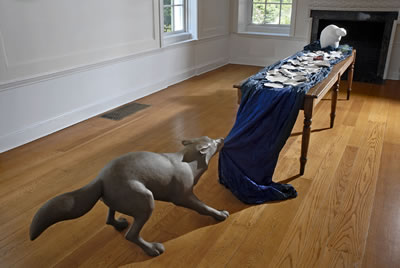
|
Lorna Mills and Sally McKay
Digital Media Tree this blog's archive OVVLvverk Lorna Mills: Artworks / Persona Volare / contact Sally McKay: GIFS / cv and contact |
View current page
...more recent posts
Sunday - Habanera

Maria Callas 1962 Covent Garden
Beaker (courtesy of Beth Stuart)






Carmen Amaya - Zambra








R.M. Vaughan reviews Mary Ann Barkhouseís The Reins of Chaos at the Latcham Gallery in Stouffville, Ont. He closes with this paragraph:
"A side note: The Reins of Chaos is related to a series of Barkhouse installations that situate animal sculptures in disjointed, otherworldly domestic settings. Her last touring exhibition, Boreal Baroque, tucked rabbits, owls and other woodland creatures into tidy, chintz-draped parlours. One canít help wondering why or how these powerful and charming works were overlooked by Adaptation: Between Species, the Power Plantís new, and very large, humans-meet-animals show. Surely one Barkhouse work is worth any two European videos?"
That of course, begs the question, how did the Power Plant's out-going curator, Helena Reckitt, manage to exclude so many First Nation's artists from Adaptation: Between Species currently on at the Power Plant?

Mary Ann Barkhouse harvest 2009 Bronze, wood, porcelain, taffeta

Mary Ann Barkhouse Boreal Baroque 2009

blingee by L.M.
Neuroscientist Gerald Edelman (who works on robotic consciousness) explains why brains and computers are not analogous.
To function, a computer must receive unambiguous input signals. But signals to various sensory receptors of the brain are not so organized; the world (which is not carved beforehand into prescribed categories) is not a piece of coded tape.
Gerald Edelman, Second Nature: Brain Science and Human Knowledge, 2006. pg.21
An Te Liu in Empire of Dreams, Phenomenology of the built environment, Contemporary Artists from Toronto at the MOCCA, 952 Queen Street W., Toronto. Until Aug. 15, 2010.
Curated By David Liss.


blingee by L.M. (of course)
The function of syntax is a central problem for computational neuroscience. For many years, artificial intelligence (AI) was the holy grail for both computer engineers and neuroscientists who wanted to unlock the secrets of consciousness. Working with Chomskian ideas of universal grammar, it was believed that meaning in the brain was derived in a similar way to meaning in a sentence. The syntactical structure of a sentence can be broken down into components which are then computed in combination to produce a composite unit of knowledge or understanding. Following from this, a detailed understanding of the component structures of the brain and how they interrelate should make it possible to create an analogous structure with computer circuits that would result in a thinking machine. Unfortunately that particular project (1st-wave AI) failed.
Josh Thorpe in Empire of Dreams, Phenomenology of the built environment, Contemporary Artists from Toronto at the MOCCA, 952 Queen Street W., Toronto. Until Aug. 15, 2010.
Curated By David Liss.


Subtractive Mural for MOCCA (after Asher and Huyghe) 2010 layers of latex paint removed to reveal historical wall colours 2005-2008

